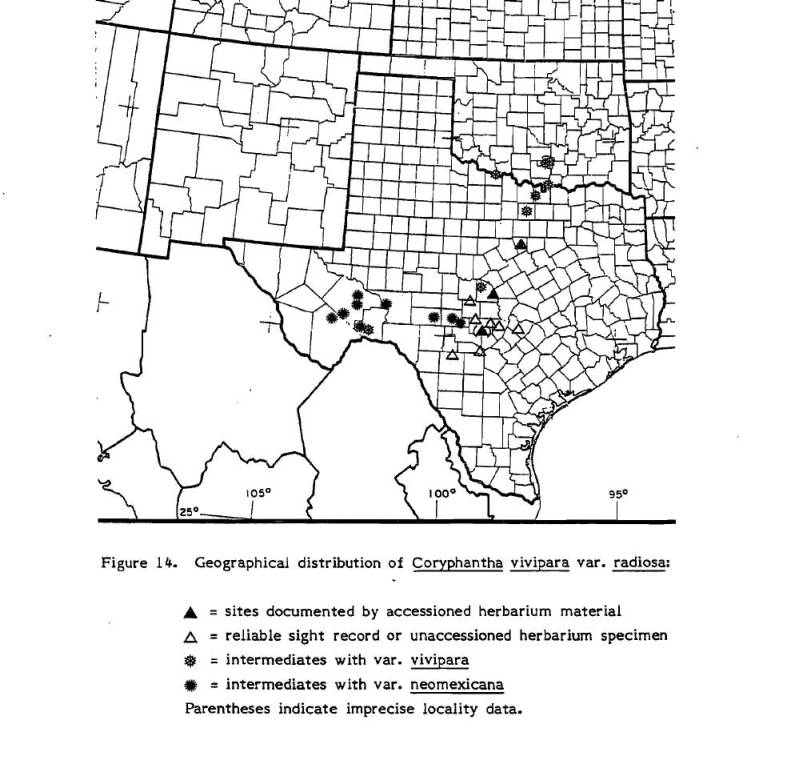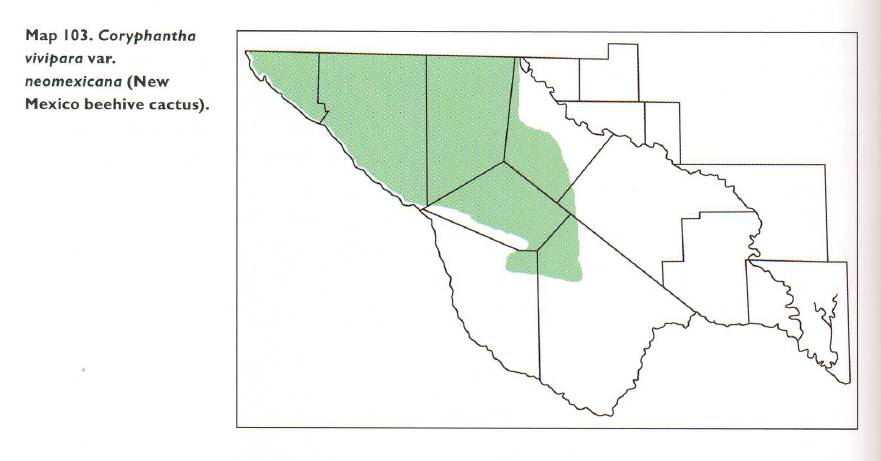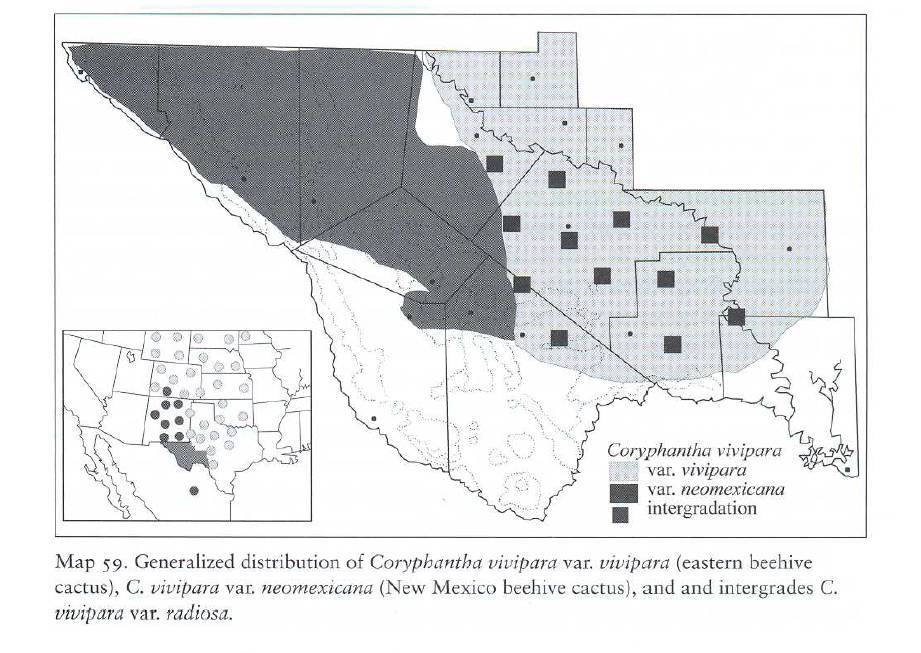Discussions - Mysterious and Unknown Escobarias
Unknown names, catalogue names, nomen nudum, nomen prov. etc.
Unknown names, catalogue names, nomen nudum, nomen prov., not described taxa:
If you recognize any taxon or if you know further information about the names listed below, please, send me an e-mail to the following address escobaria@atlas.cz .
 |
Escobaria spec. - Barber Crossing (Guadalupe Mts.) |
|
Do you know what is the Escobaria in this photograph? Grows in the Guadalupe Mts. Photo - Zdenek Vasko | |
Notes: | |
|
Jan Mynar (25.01.2013) - e-mail: escobaria@atlas.cz Zdenek Vasko asks, what is this plant? It grows in the Guadalupe Mts., particularly in Barber Crossing, Eddy Co., New Mexico, USA (VZD 454). 
 Escobaria spec. - Barber Crossing, Guadalupe Mts., Eddy Co., New Mexico, USA (VZD 454). 

 Escobaria spec. - Barber Crossing (VZD 454), the collection of Zdenek Vasko.
| |
|
Vladislav Sedivy (25.01.2013) - e-mail: vladsedivy@centrum.cz If I am correct Barber Crossing is located in an altitude of just over 1000 meters; E. guadalupensis is found in double the altitude, at least. Flower does not fit either - it is small, as with E. sneedii. According to my observations, sitting at a table and based just on the documents it is one of the forms of E. vivipara var. neomexicana, which might appear in Guadalupe Mts as well. Translation by Jana Mynarova | |
|
Vít Zavadil (25.01.2013) - e-mail: arnoviza@seznam.cz Unfortunately, I have not been in the U.S., but plants of this appearance including the flower are grown here under the Esc. vivipara ssp. radiosa name. These are partly cold-hardy. Until the last winter I was able to plant these outdoors, but the temperatures reaching below -20°C destroyed the plants. Translation by Jana Mynarova | |
|
Hans Havel (26.01.2013) - e-mail: hahavel@aon.at I do not know Barber Crossing, but I have been to Guadalupe Mts several times and vivipara having white spines with central spines with lightly brown tips are common at Pine Springs and Mc Kittrick Canyon in the southern part of Guadalupe Mts., Culberson Co., Tx, as well as in Carlsbad Cavern Nt. Park. These white vivipara can be also found along US82 from Hope to south-eastern tip of Sacramento Mts. All these plants have got slender usually dark-coloured petals. Altitude is around 1200-1800 m. The plants look very different on the northwest side of the Sacramento Mts, in "A Mountain" at Las Cruces, in the San Augustin Pass between Alamogordo and Las Cruzes, where other habitats are located. Spines are not so white, but the marginal spines are lighter with brown to reddishbrown coloured central spines, and the petals are shorter and not so slender. I cannot answer the question if this is Esc. vivipara var. neomexicana, because until now I do not know whether the described plants are intermediate or mixed forms with Esc. vivipara var. radiosa or whether we can consider both forms as Esc. vivipara var. neomexicana. I have not been able to find the type locality in the literature. Unfortunately, no clear result can be obtained either based on the number of spines. There are various (overlapping) results among different sites, as well as among various plants located at one site. I have made good experiences with the altitude of the individual habitats. The respective habitats reveal most likely classification of the plants. Nevertheless, the information presented by various authors differs significantly. Translation by Jana Mynarova ; Original | |
|
Jaroslav Snicer (27.01.2013) - e-mail: cult.tricka@seznam.cz It is certainly a vivipara. I am not sure contrary to V. Sedivy, that it is a neomecicana. It is interesting, that the plants from Guadalupe Mts. are mostly white. We watched it at Rattesnake Canyon. Photos of Zdenek Vasko are looking to the similar terrain. I'd guess starts down the Hills. E. guadalupensis is from the E. orcuttii ring and the character of the spines is therefore totally different. Translation by Jan Mynar | |
|
Hans Havel (28.01.2013) - e-mail: hahavel@aon.at Als Ergänzung zu meinem Beitrag: Für mich ist es keine Frage, diese Pflanze gehört eindeutig zu Esc. vivipara. Nur die Varietät ist nicht klar. Esc. guadalupensis wächst in der Gipfelregion der Guadalupe Mts. ab ca 2000 m, sowie es Herr V. Sedivy richtig sagte. Dazu ein Foto einer Esc. guadalupensis, Blütendurchmesser ungefähr 20 mm.  Escobaria guadalupensis Meine Unsicherheit bei allen Esc. viviparas ist die Zuordnung zu einer der bekannten Varietäten oder die Abgrenzung der Varietäten untereinander. E. Anderson / U. Eggli und die Autoren D. Hunt, N. Taylor und G. Charles haben als Lösung des Problems alle Varietäten eleminiert. Als Ausnahme haben sie Esc. alversonii und Esc. desertii von Esc. vivipara abgetrennt und als eigene Arten festgelegt. Diese Vorgangsweise hat sicher auch Berechtigung, da die Abgrenzung der Arten durch getrennte Areale nicht gegeben ist und es zweifellos Übergangs / Mischformen gibt. Allerdings fällt es mir schwer mich an diese Hypothese / Statement zu gewöhnen. Haben doch die Pflanzen über weite Strecken gleiches Aussehen und Eigenschaften. Ob eine generativen Vermehrung zwischen den Varietäten möglich ist habe ich in einen Versuch nie ausprobiert. Habe ich doch den Willen Pflanzen einzelner Standorte rein zu vermehren. Die alten Beschreibungen sind auf Grund der damals nicht vorhandenen Kenntnisse über Verbreitungsgebiet und den verschiedenen Standorten unbrauchbar. Vielleicht sollte man über den zweiten Teil meines mail eine eigene Diskussion machen.
| |
|
Jan Mynar (28.01.2013) - e-mail: escobaria@atlas.cz Nach Zimmermann (1985) kommt E. vivipara var. neomexicana in Gebiet von Guadalupe Mts. vor. E. vivipara var. radiosa erscheint bis in Zentraltexas. Mischformen hat Zimmermann im südwestlichen Teil von Texas in Pecos Co., Brewster Co., Terrell Co. und Crockett Co. identifiziert, d.h. südlich von Guadalupe Mts. 
 pøevzato - Zimmermann (1985): Systematics of the genus Coryphantha (Cactaceae), PhD. thesis Powell und Weedin (2004), resp. Powell et all (2008): Cacti of Texas. A Field Guide, führen an, dass nur E. vivipara var. neomexicana auch hier vorkommt. Taxa E. vivipara var. radiosa, resp. E. vivipara var. radiosa kommen östlich von der beschriebenen Lokalität vor. 
 pøevzato - Powell et all (2008): Cacti of Texas. A Field Guide  pøevzato - Powell et Weedin (2004): Cacti of the Trans-Pecos and Adjacent Areas
| |
|
Jaroslav Snicer (28.01.2013) - e-mail: cult.tricka@seznam.cz Bei Steven Brack haben wir ähnliche Pflanzen von Crocket Co. als var. radiosa gesehen. Ich neige vielmehr zu dieser Ansicht. Vegetationsraum künpft an südliches Gebiet an und deshalb sehe ich darin kein Problem. Übersetzung: Jan Mynáø | |
Contributions to individual taxa send please to the following e-mail address escobaria@atlas.cz .
A form to create a new discussion page - new discussion .

© 2002-2013 Jan Mynar
Last modified January 28, 2013
[ Discussions - Mysterious and Unknown Escobarias ] [ Discussions ] [ HOME ]